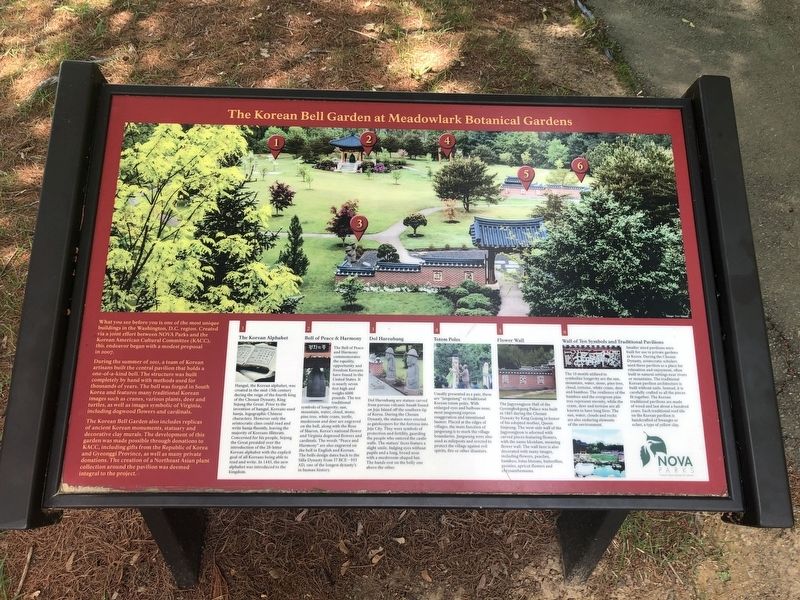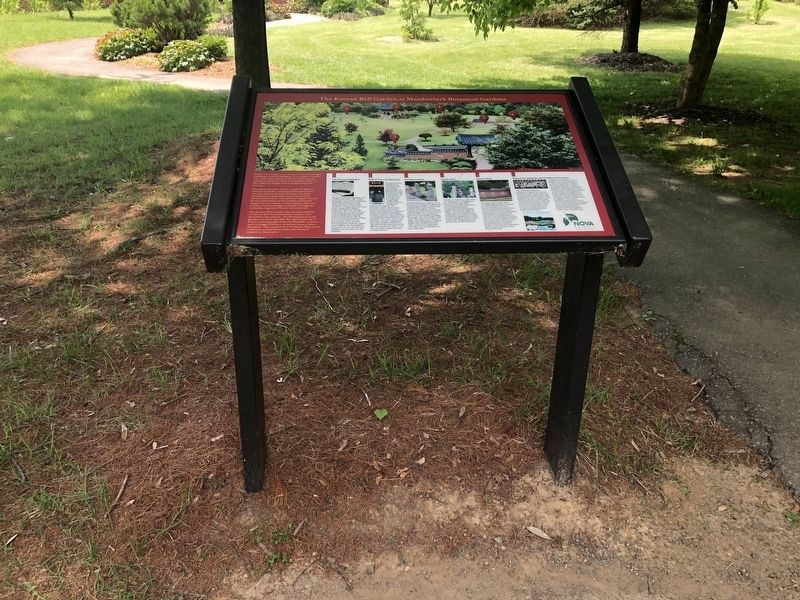Near Vienna in Fairfax County, Virginia — The American South (Mid-Atlantic)
The Korean Bell Garden at Meadowlark Botanical Gardens

Photographed By Devry Becker Jones (CC0), June 13, 2020
1. The Korean Bell Garden at Meadowlark Botanical Gardens Marker
What you see before you is one of the most unique buildings in the Washington, D.C. region. Created via a joint effort between NOVA Parks and the Korean American Cultural Committee (KACC), this endeavor began with a modest proposal in 2007.
During the summer of 2011, a team of Korean artisans built the central pavilion that holds a one-of-a-kind bell. The structure was built completely by hand with methods used for thousands of years. The bell was forged in South Korea and features many traditional Korean images such as cranes, various plants, deer and turtles, as well as images symbolic of Virginia, including dogwood flowers and cardinals.
The Korean Bell Garden also includes replicas of ancient Korean monuments, statuary and decorative clay murals. The development of this garden was made possible through donations to KACC, including gifts from the Republic of Korea and Gyeonggi Province, as well as many private donations. The creation of a Northeast Asian plant collection around the pavilion was deemed integral to the project.
1. The Korean Alphabet
Hangul, the Korean alphabet, was created in the mid-15th century during the reign of the fourth king of the Chosun dynasty, King Sejong the Great. Prior to the invention of hangul, Koreans used hanja, logographic Chinese characters. However only the aristocratic class could read and write hanja fluently, leaving the majority of Koreans illiterate. Concerned for his people, Sejong the Great presided over the introduction of the 28-letter Korean alphabet with the explicit goal of all Koreans being able to read and write. In 1443, the new alphabet was introduced to the kingdom.
2. Bell of Peace & Harmony
The Bell of Peace and Harmony commemorates the equality, opportunity and freedom Koreans have found in the United States. It is nearly seven feet high and weighs 6000 pounds. The ten traditional symbols of longevity; sun, mountain, water, cloud, stone, pine trees, white crane, turtle, mushroom and deer are engraved on the bell, along with the Rose of Sharon, Korea's national flower and Virginia dogwood flowers and cardinals. The words "Peace and Harmony" are also engraved on the bell in English and Korean. The bells design dates back to the Silla Dynasty from 57 BCE - 935 AD, one of the longest dynasties in human history.
3. Dol Hareubang
Dol Hareubang are statues carved from porous volcanic basalt found on Jeju Island off the southern tip of Korea. During the Chosun Dynasty, the statues were erected as gatekeepers for the fortress into Jeju City. They were symbols of protection and fertility, guarding

Photographed By Devry Becker Jones (CC0), June 13, 2020
2. The Korean Bell Garden at Meadowlark Botanical Gardens Marker
4. Totem Poles
Usually presented as a pair, these are "jangseung" or traditional Korean poles. With enlarged eyes and bulbous nose, most jangseung express exaggeration and intentional humor. Placed at the edges of villages, the main function of jangseung is to mark the village boundaries. Jangseung were also used as mileposts and erected to protect the village against evil spirits, fire or other disasters.
5. Flower Wall
The Jagyeongjeon Hall of the Gyeongbokgung Palace was built in 1865 during the Chosun Dynasty by King Gojung in honor of his adopted mother, Queen Sinjeong. The west-side wall of the Jagyeongjeon is adorned with carved pieces featuring flowers, with the name kkotdam, meaning flower wall. The wall here is also decorated with many images, including flowers, peaches, bamboo, lotus flowers, peaches, bamboo, lotus blooms, butterflies, peonies, apricot flowers and chrysanthemums.
6. Wall of Ten Symbols and Traditional Pavilions
The 10 motifs utilized to symbolize longevity are the sun, mountain, water, stone, pine tree, cloud, tortoise, white crane, deer and bamboo. the resilience of the bamboo and the evergreen pine tree represent eternity, while the crane, deer and tortoise are all known to have long lives. The sun, water, clouds and rocks are also enduring elements of the environment.
Similar sized pavilions were built for use in private gardens in Korea. During the Choson Dynasty, aristocratic scholars used these pavilion as a place for relaxation and enjoyment, often built in natural settings near rivers or mountains. The traditional Korean pavilion architecture is built without nails. Instead, it is carefully crafted so all the pieces fit together. The Korean traditional pavilions are made of wood and last about a hundred years. Each traditional roof tile on the Korean pavilion is handcrafted of hwangto or ocher, a type of yellow clay.
Erected by NOVA Parks.
Topics and series. This historical marker is listed in these topic lists: Anthropology & Archaeology • Churches & Religion • Communications • Peace. In addition, it is included in the NOVA Parks series list. A significant historical year for this entry is 2007.
Location. 38° 56.207′ N, 77° 17.061′ W. Marker is near Vienna, Virginia, in Fairfax County. Marker can be reached from Beulah Road (Virginia Route 702) south of Chathams Ford Drive, on the right when traveling south. Touch for map. Marker is at or near this postal address: 1624 Beulah Rd, Vienna VA 22182, United States of America. Touch for directions.
Other nearby markers. At least 8 other markers are within walking distance of this marker. The Bell of Peace and Harmony (within shouting distance of this marker); The Purpose of the Korean Bell Garden (about 300 feet away, measured in a direct line); Metasequoia glyptostroboides (about 500 feet away); Jeju Dolhareubang (about 500 feet away); The Springhouse (about 600 feet away); Gardiner C. Means and Caroline F. Ware (approx. 0.2 miles away); The Cabin (approx. 0.2 miles away); The Means-Ware Farm (approx. 0.2 miles away). Touch for a list and map of all markers in Vienna.
Credits. This page was last revised on May 16, 2022. It was originally submitted on June 14, 2020, by Devry Becker Jones of Washington, District of Columbia. This page has been viewed 323 times since then and 50 times this year. Last updated on August 26, 2020, by Carl Scott Zimmerman of Kirkwood, Missouri. Photos: 1, 2. submitted on June 14, 2020, by Devry Becker Jones of Washington, District of Columbia.